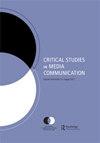回顾社交媒体和仇恨
IF 1.5
2区 文学
Q3 COMMUNICATION
引用次数: 0
摘要
世界主义和消费主义。第一个案例研究的焦点是Alex,一位在RTÉ医疗剧《诊所》(2003-2009)中的澳大利亚同性恋护士,他被塑造成一个现代的、世界主义者和新自由主义者。第二个案例研究是犯罪剧《证明》(Proof, 2004-2005),它分析了两个处于凯尔特之虎经济边缘的角色,他们通过对边缘人物的描绘,挑战了《诊所》中流行的关于同性恋文化的刻板印象。在结束语中,作者认为LGBTQ活动创造了2015年成功的同性婚姻公投期间的大部分媒体知名度。体面和主流化被证明是这场运动的支柱,类似于20世纪70年代的激进主义策略。最后,Kerrigan呼吁在酷儿媒体研究中采用更多样化的方法,并对跨性别者、双性恋者和女同性恋者在这类研究中的代表性不足表示担忧。这本书对酷儿研究和媒体研究领域做出了杰出的贡献,在对爱尔兰媒体中LGBTQ可见度的复杂分析方面开辟了新的领域。通过关注可见性和正常化的相互作用,它突出了围绕体面政治和少数民族代表性的紧张关系。尽管理论材料很复杂,但这本书可读性很强,凯瑞根熟练地使用了各种原始资料。虽然承认有必要限制任何研究的范围,但考虑到这是一本几乎完全关于电视的书,或者实际上只关于RTÉ的书,标题中声称涵盖媒体多少有些误导。考虑到这种主导地位,第四章中简要地回避到酷儿媒体和独立纪录片(无论如何最终在RTÉ上放映)的决定是象征性的。最好是将其作为一本关于RTÉ的书,同时在引言中提供其他媒体的概述。例如,20世纪80年代多样化的爱尔兰海盗电台和90年代以来获得许可的社区媒体都为酷儿的表现提供了创新的空间。同样,凯瑞根也没有称赞爱尔兰语电视频道TG4,该频道在1996年开播时曾在其肥皂剧中出现过一对同性恋夫妇。对这些材料的讨论将丰富第六章中所提到的关于凯尔特之虎时期爱尔兰民族认同重构的分析。本文章由计算机程序翻译,如有差异,请以英文原文为准。
Review of Social Media and Hate
cosmopolitanism and consumerism. The first case study focuses on Alex, a gay Australian nurse in the RTÉ medical drama The Clinic (2003–2009), who is framed as modern, cosmopolitan, and neoliberal. The second case study, crime drama Proof (2004–2005), analyzes two characters on the fringes of the Celtic Tiger economy who, through their portrayal as marginal, challenge stereotypical narratives around gay culture prevalent in The Clinic. In the conclusion, it is argued that LGBTQ activism created much of the media visibility achieved during the successful 2015 same-sex marriage referendum. Respectability and mainstreaming are shown to have been mainstays of the campaign, similar to activist strategies of the 1970s. Kerrigan concludes by calling for more diverse approaches in queer media research and expresses concern that transgender people, bisexuals, and lesbians remain underrepresented in such research. This book is an excellent contribution to the fields of queer studies and media studies and breaks new ground in its sophisticated analysis of LGBTQ visibility in Irish media. Through focusing on the interplay of visibility and normalization, it highlights the tensions surrounding respectability politics and minority representation. Despite the complexity of the theoretical material, the book is very readable and Kerrigan makes masterful use of diverse primary sources. While acknowledging the need to limit the scope of any study, the claim in the title to cover media is somewhat misleading, given that this is a book almost entirely about television, or in fact RTÉ alone. Given that dominance, the decision in Chapter 4 to briefly sidestep into the queer press and independent documentaries (which ended up being shown on RTÉ anyway) is tokenistic. It would have been preferable to present this as a book about RTÉ while providing an overview of other media in the introduction. For instance, the diverse Irish pirate radio scene in the 1980s and licensed community media since the 1990s both provided innovative spaces for queer representation. Similarly, Kerrigan gives no credit to Irish language television channel TG4, which included a gay couple in its soap opera when it launched in 1996. A discussion of such material would enrich the analysis about the reframing of Irish national identity during the Celtic Tiger era broached in Chapter 6.
求助全文
通过发布文献求助,成功后即可免费获取论文全文。
去求助
来源期刊

Critical Studies in Media Communication
COMMUNICATION-
CiteScore
2.10
自引率
0.00%
发文量
34
期刊介绍:
Critical Studies in Media Communication (CSMC) is a peer-reviewed publication of the National Communication Association. CSMC publishes original scholarship in mediated and mass communication from a cultural studies and/or critical perspective. It particularly welcomes submissions that enrich debates among various critical traditions, methodological and analytical approaches, and theoretical standpoints. CSMC takes an inclusive view of media and welcomes scholarship on topics such as • media audiences • representations • institutions • digital technologies • social media • gaming • professional practices and ethics • production studies • media history • political economy. CSMC publishes scholarship about media audiences, representations, institutions, technologies, and professional practices. It includes work in history, political economy, critical philosophy, race and feminist theorizing, rhetorical and media criticism, and literary theory. It takes an inclusive view of media, including newspapers, magazines and other forms of print, cable, radio, television, film, and new media technologies such as the Internet.
 求助内容:
求助内容: 应助结果提醒方式:
应助结果提醒方式:


